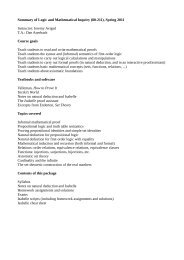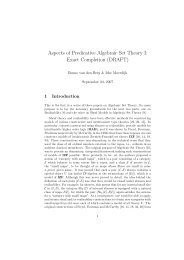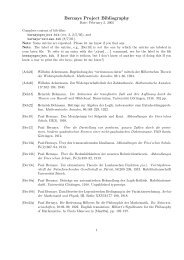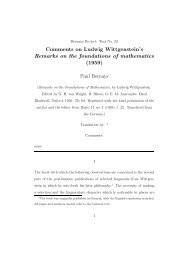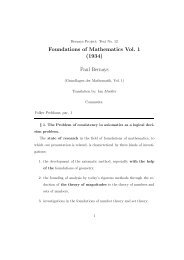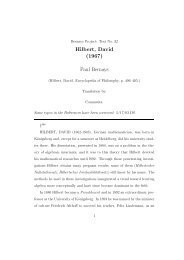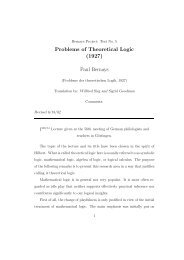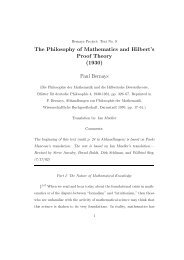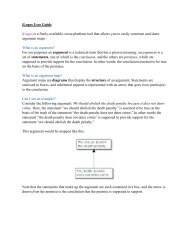Logic and Formal Verification - Phil Cmu
Logic and Formal Verification - Phil Cmu
Logic and Formal Verification - Phil Cmu
Create successful ePaper yourself
Turn your PDF publications into a flip-book with our unique Google optimized e-Paper software.
<strong>Logic</strong> <strong>and</strong> <strong>Formal</strong> <strong>Verification</strong><br />
Lecture notes<br />
Jeremy Avigad<br />
Version: June, 2009
Contents<br />
1 Propositional logic 1<br />
1.1 Natural deduction . . . . . . . . . . . . . . . . . . . . . . . . 1<br />
1.2 Some propositional validities . . . . . . . . . . . . . . . . . . 5<br />
1.3 Excercises . . . . . . . . . . . . . . . . . . . . . . . . . . . . . 8<br />
1.4 Using Isabelle . . . . . . . . . . . . . . . . . . . . . . . . . . . 9<br />
1.5 Exercises . . . . . . . . . . . . . . . . . . . . . . . . . . . . . 11<br />
1.6 A completeness proof . . . . . . . . . . . . . . . . . . . . . . . 11<br />
2 First-order logic 13<br />
2.1 Quantifiers in natural deduction . . . . . . . . . . . . . . . . 13<br />
2.2 Some first-order validities . . . . . . . . . . . . . . . . . . . . 14<br />
2.3 Exercises . . . . . . . . . . . . . . . . . . . . . . . . . . . . . 15<br />
2.4 Quantifiers in Isabelle . . . . . . . . . . . . . . . . . . . . . . 16<br />
2.5 Exercises . . . . . . . . . . . . . . . . . . . . . . . . . . . . . 16<br />
2.6 Equality <strong>and</strong> Isabelle’s simplifier . . . . . . . . . . . . . . . . 17<br />
2.7 First-order theories . . . . . . . . . . . . . . . . . . . . . . . . 18<br />
2.8 Using Isabelle’s automated tools . . . . . . . . . . . . . . . . 18<br />
2.9 Exercises . . . . . . . . . . . . . . . . . . . . . . . . . . . . . 19<br />
2.10 Completeness for first-order logic . . . . . . . . . . . . . . . . 19<br />
3 The natural numbers 21<br />
3.1 Induction <strong>and</strong> recursion on the natural numbers . . . . . . . . 21<br />
3.2 Exercises . . . . . . . . . . . . . . . . . . . . . . . . . . . . . 23<br />
3.3 The natural numbers in Isabelle . . . . . . . . . . . . . . . . . 24<br />
3.4 Exercises . . . . . . . . . . . . . . . . . . . . . . . . . . . . . 25
ii<br />
CONTENTS
Chapter 1<br />
Propositional logic<br />
1.1 Natural deduction<br />
In this workshop, I will assume that you are familiar with the syntax <strong>and</strong><br />
semantics of propositional <strong>and</strong> first-order logic. In other words, I will assume<br />
that you are able to read <strong>and</strong> write expressions in propositional <strong>and</strong> firstorder<br />
logic, <strong>and</strong> underst<strong>and</strong> what they mean. Henceforth, by “logic,” I mean<br />
classical logic.<br />
In discussing propositional logic, I will take p, q, r, . . . to range over<br />
propositional variables, <strong>and</strong> ϕ, ψ, θ, . . . to range over formulas. It is common<br />
to take the basic connectives to be ∧, ∨, →, ⊥. Additional connectives<br />
¬, ↔, ⊤ can be defined by<br />
• ¬ϕ ≡ ϕ → ⊥<br />
• ⊤ ≡ ¬⊥<br />
• (ϕ ↔ ψ) ≡ (ϕ → ψ) ∧ (ψ → ϕ).<br />
In fact, in classical propositional logic, there is redundancy even in the<br />
original list: you can get by, for example, with → <strong>and</strong> ⊥ alone.<br />
I assume that you are familiar with truth-table semantics. A propositional<br />
formula ϕ is said to be valid, or a tautology, if ϕ is true under every<br />
assignment. This is written |= ϕ. More generally, if Γ is a set of formulas<br />
<strong>and</strong> ϕ is a formula, Γ entails ϕ, written Γ |= ϕ, if ϕ is true under every truth<br />
assignment that makes every formula in Γ true. For example, computing<br />
truth tables shows that the following hold:<br />
• |= p ∧ q → q ∨ r<br />
1
2 CHAPTER 1. PROPOSITIONAL LOGIC<br />
• {q, p ∧ r} |= q ∧ r<br />
I will work through these examples in class.<br />
The purpose of a proof system is to provide a system of rules which is<br />
sufficient to verify all valid formulas <strong>and</strong> entailments. We will use a system of<br />
natural deduction, due to Gerhard Gentzen. In this system, the basic object<br />
is a proof of a formula from some hypotheses; the rules of the system enable<br />
us to construct complex proofs from simpler ones. Rules are associated<br />
to each connective, characterizing its proper usage. In particular, for each<br />
logical connective we wish to have introduction rules, which tells us what<br />
is needed to justify an assertion involving this connective; <strong>and</strong> elimination<br />
rules, which tell what we may legitimately infer from such an assertion. For<br />
example, here are the rules for conjunction:<br />
ϕ ψ ∧I<br />
ϕ ∧ ψ<br />
ϕ ∧ ψ ∧E1<br />
ϕ<br />
ϕ ∧ ψ ∧E2<br />
ψ<br />
A key feature of natural deduction is that the notion of a proof from hypotheses<br />
is central, with the underst<strong>and</strong>ing that hypotheses can not only<br />
be introduced but also “cancelled” during a proof. So one should read the<br />
introduction rule for ∧ as follows: given a proof of ϕ from some hypotheses,<br />
<strong>and</strong> a proof of ψ from hypotheses, one obtains a proof of ϕ ∧ ψ from the<br />
union of the two sets of hypotheses. The first elimination rule for ∧ says<br />
that given a proof of ϕ ∧ ψ from some hypotheses, one obtains a proof of ϕ<br />
from the same set of hypotheses. These are the rules for implication:<br />
ϕ<br />
.<br />
ψ<br />
ϕ → ψ<br />
→I<br />
ϕ → ψ<br />
ψ<br />
ϕ →E<br />
The introduction rule is the interesting one, since it involves cancelling a<br />
hypothesis. Informally, it says that in order to prove ϕ → ψ, it suffices to<br />
assume ϕ <strong>and</strong> conclude ψ. The three dots suggest a proof of ψ in which<br />
the assumption ϕ can be used any number of times. In concluding ϕ →<br />
ψ, this assumption is made explicit. In the resulting proof, then, ϕ is no<br />
longer an assumption; it has been “cancelled.” More precisely, then, the<br />
introduction rule for → should be read as follows: given a proof of ψ from<br />
some hypotheses, which may include ϕ, one obtains a proof of ϕ → ψ, from<br />
the same set of hypotheses except for the fact that ϕ may be cancelled.<br />
The rules for disjunction are as follows:
1.1. NATURAL DEDUCTION 3<br />
ϕ<br />
ϕ ∨ ψ<br />
∨I 1<br />
ψ<br />
ϕ ∨ ψ<br />
∨I 2<br />
ϕ ∨ ψ<br />
θ<br />
ϕ<br />
.<br />
θ<br />
ψ<br />
.<br />
θ ∨E<br />
While the introduction rules are clear, the elimination rule may seem confusing.<br />
On reflection, however, it can be seen to model the natural process<br />
of proving θ from ϕ ∨ ψ by branching on cases: “Suppose ϕ ∨ ψ. Case 1: ϕ<br />
holds. . . . <strong>and</strong> θ follows. Case 2: ψ holds. . . . <strong>and</strong> θ follows. Either way, we<br />
have θ.” Notice that in the resulting inference, the hypotheses ϕ <strong>and</strong> ψ are<br />
cancelled.<br />
Finally, we add one last rule, reductio ad absurdum.<br />
¬ϕ<br />
.<br />
⊥<br />
ϕ<br />
This is the only rule that is not intuitionistically valid. (For intuitionistic<br />
logic, one replaces this rule with a weak rule, ex falso sequitur quodlibet,<br />
allowing us to derive any conclusion from ⊥.)<br />
Remembering that ¬ϕ abbreviates ϕ → ⊥, the natural introduction<br />
<strong>and</strong> elimination rules for negation follow from the corresponding rules for<br />
implication:<br />
ϕ<br />
.<br />
⊥ ¬I ¬ϕ<br />
¬ϕ ϕ ¬E<br />
⊥<br />
Similarly, we have the following derived rules for ↔:<br />
ϕ<br />
ψ<br />
. .<br />
ψ ϕ ↔ I<br />
ϕ ↔ ψ<br />
ϕ ↔ ψ<br />
ψ<br />
ϕ ↔ E1<br />
ϕ ↔ ψ<br />
ϕ<br />
ψ ↔ E2<br />
Don’t confuse reductio ad absurdum with negation introduction (the former<br />
is not valid in intuitionistic logic, whereas the latter is). Of course, we need<br />
to have a rule with no hypotheses to get started. Here it is:<br />
ϕ
4 CHAPTER 1. PROPOSITIONAL LOGIC<br />
This is called the assumption rule, <strong>and</strong> has a trivial reading: we can always<br />
prove ϕ, assuming ϕ as a hypothesis. The fact that this is an open hypothesis<br />
will be clear diagrammatically, because there is no line over ϕ; if <strong>and</strong> when<br />
this hypothesis is cancelled, we put a line over it.<br />
Reading a natural deduction proof can be difficult because hypotheses<br />
are introduced <strong>and</strong> cancelled at various times. In particular, it is useful to<br />
know at which points in a proof particular hypotheses have been cancelled.<br />
This information is conveyed by labelling the hypothesis <strong>and</strong> the point that<br />
it is cancelled with a letter x, y, z, . . .. For example, the following is a proof<br />
of ψ → (ϕ ∧ ψ) from hypothesis ϕ:<br />
ϕ ψ<br />
ϕ ∧ ψ<br />
ψ → ϕ ∧ ψ<br />
One more instance of →I yields a proof of ϕ → (ψ → ϕ ∧ ψ):<br />
y<br />
ϕ ψ<br />
ϕ ∧ ψ<br />
ψ → ϕ ∧ ψ<br />
x<br />
x<br />
x<br />
x<br />
ϕ → (ψ → ϕ ∧ ψ)<br />
There is some legalistic fine print associated with the implication introduction<br />
rule (similar considerations apply to disjunction elimination as<br />
well). Properly stated, the rule should be read as follows: “Given ψ, you<br />
are may conclude ϕ → ψ. Furthermore, if ϕ occurs as a hypothesis, you<br />
may cancel any instances of this hypothesis.” Note that you do not need<br />
the hypothesis ϕ to conclude ϕ → ψ; if you know ψ outright, you know<br />
ϕ → ψ. We need this flexibility, for example, to derive the first schema in<br />
our axiomatic proof systems:<br />
x<br />
ψ<br />
ϕ → ψ<br />
ψ → (ϕ → ψ)<br />
Furthermore, nothing is harmed if we leave some of the hypotheses open<br />
when we could have cancelled them; again, this only weakens the proof.<br />
With this convention in mind, note that the ex falso rule can be viewed as<br />
a special case of double-negation elimination.<br />
It will be helpful to have a description of natural deduction that keeps<br />
track of the open hypotheses at each stage of the proof. A pair (Γ, ϕ), where<br />
x<br />
y
1.2. SOME PROPOSITIONAL VALIDITIES 5<br />
Γ is a finite set of formulas <strong>and</strong> ϕ is a propositional formula, will formally be<br />
called a sequent, <strong>and</strong> will be written Γ ⇒ ϕ. Intuitively, this sequent should<br />
be read as the assertion that we have established ϕ from hypotheses in Γ.<br />
If Γ is a set of formulas <strong>and</strong> ψ is a formula, it is convenient to write Γ, ψ for<br />
Γ ∪ {ψ}; <strong>and</strong>, more generally, it is convenient to leave off curly braces when<br />
listing the elements of a finite set. With this new mode of presentation, the<br />
natural deduction rules are expressed as follows:<br />
Γ, ϕ ⇒ ϕ<br />
Assumption<br />
Γ ⇒ ϕ Γ ⇒ ψ ∧I<br />
Γ ⇒ ϕ ∧ ψ<br />
Γ ⇒ ϕ 0 ∧ ϕ 1<br />
Γ ⇒ ϕ i<br />
∧E i<br />
Γ ⇒ ϕ i<br />
Γ ⇒ ϕ ∨ ψ Γ, ϕ ⇒ θ Γ, ψ ⇒ θ<br />
∨I i<br />
∨E<br />
Γ ⇒ ϕ 0 ∨ ϕ 1 Γ ⇒ θ<br />
Γ, ϕ ⇒ ψ<br />
Γ ⇒ ϕ → ψ<br />
→I<br />
Γ ⇒ ϕ → ψ<br />
Γ ⇒ ψ<br />
Γ ⇒ ϕ →E<br />
Γ, ¬ϕ ⇒ ⊥ RAA<br />
Γ ⇒ ϕ<br />
One can show that if it is possible to prove Γ ⇒ ϕ then it is possible<br />
to prove Γ ∪ ∆ ⇒ ϕ for any set ∆. This is known as “weakening” the<br />
set of hypotheses. In practice, it is more convenient to fold weakening into<br />
the rules by allowing any subset of Γ in the hypotheses. For example, the<br />
following proof tree witnesses ⊢ ϕ → (ψ → ϕ ∧ ψ):<br />
ϕ ⇒ ϕ Ax<br />
Ax<br />
ψ ⇒ ψ ∧I<br />
ϕ, ψ ⇒ ϕ ∧ ψ<br />
→I<br />
ϕ ⇒ ψ → ϕ ∧ ψ<br />
⇒ ϕ → (ψ → ϕ ∧ ψ)<br />
→I<br />
1.2 Some propositional validities<br />
Here are some propositional validities:<br />
1. Commutativity of ∧: ϕ ∧ ψ ↔ ψ ∧ ϕ<br />
2. Commutativity of ∨: ϕ ∨ ψ ↔ ψ ∨ ϕ
6 CHAPTER 1. PROPOSITIONAL LOGIC<br />
3. Associativity of ∧: (ϕ ∧ ψ) ∧ θ ↔ ϕ ∧ (ψ ∧ θ)<br />
4. Associativity of ∨: (ϕ ∨ ψ) ∨ θ ↔ ϕ ∨ (ψ ∨ θ)<br />
5. Distributivity of ∧ over ∨: ϕ ∧ (ψ ∨ θ) ↔ (ϕ ∧ ψ) ∨ (ϕ ∧ θ)<br />
6. Distributivity of ∨ over ∧: ϕ ∨ (ψ ∧ θ) ↔ (ϕ ∨ ψ) ∧ (ϕ ∨ θ)<br />
7. (ϕ → (ψ → θ)) ↔ (ϕ ∧ ψ → θ).<br />
8. (ϕ → ψ) → ((ψ → θ) → (ϕ → θ))<br />
9. ((ϕ ∨ ψ) → θ) ↔ (ϕ → θ) ∧ (ψ → θ)<br />
10. ¬(ϕ ∨ ψ) ↔ ¬ϕ ∧ ¬ψ<br />
11. ¬(ϕ ∧ ψ) ↔ ¬ϕ ∨ ¬ψ<br />
12. ¬(ϕ ∧ ¬ϕ)<br />
13. ¬(ϕ → ψ) ↔ ϕ ∧ ¬ψ<br />
14. ¬ϕ → (ϕ → ψ)<br />
15. (¬ϕ ∨ ψ) ↔ (ϕ → ψ)<br />
16. ϕ ∨ ⊥ ↔ ϕ<br />
17. ϕ ∧ ⊥ ↔ ⊥<br />
18. ϕ ∨ ¬ϕ<br />
19. ¬(ϕ ↔ ¬ϕ)<br />
20. (ϕ → ψ) ↔ (¬ψ → ¬ϕ)<br />
21. (ϕ → θ ∨ η) → ((ϕ → θ) ∨ (ϕ → η))<br />
22. (((ϕ → ψ) → ϕ) → ϕ)<br />
There is a simple heuristic for searching for proofs: work backwards from<br />
the goal using introduction rules, <strong>and</strong> work forwards from the hypothesis<br />
using elimination rules, until all the pieces come together. For example,<br />
here is a proof of the forward direction of (5):
1.2. SOME PROPOSITIONAL VALIDITIES 7<br />
ϕ ∧ (ψ ∨ σ)<br />
ψ ∨ σ<br />
y<br />
y<br />
ϕ ∧ (ψ ∨ σ)<br />
x ϕ ∧ (ψ ∨ σ)<br />
ϕ ψ ϕ σ<br />
x<br />
ϕ ∧ ψ<br />
(ϕ ∧ ψ) ∨ (ϕ ∧ σ)<br />
(ϕ ∧ ψ) ∨ (ϕ ∧ σ)<br />
ϕ ∧ σ<br />
(ϕ ∧ ψ) ∨ (ϕ ∧ σ)<br />
x<br />
(ϕ ∧ (ψ ∨ σ)) → ((ϕ ∧ ψ) ∨ (ϕ ∧ σ))<br />
Here is a proof of the forward direction of (7):<br />
ϕ → (ψ → θ)<br />
ψ → θ<br />
y<br />
ϕ ∧ ψ<br />
ϕ<br />
x<br />
θ<br />
ϕ ∧ ψ → θ<br />
x<br />
ϕ ∧ ψ<br />
ψ<br />
(ϕ → (ψ → θ)) → (ϕ ∧ ψ → θ)<br />
Here is a proof of the forward direction of (10):<br />
z<br />
¬(ϕ ∨ ψ)<br />
⊥<br />
¬ϕ<br />
x<br />
ϕ<br />
z<br />
ϕ ∨ ψ<br />
¬(ϕ ∨ ψ)<br />
⊥<br />
x<br />
¬ψ<br />
¬ϕ ∧ ¬ψ<br />
z<br />
¬(ϕ ∨ ψ) → ¬ϕ ∧ ¬ψ<br />
y<br />
x<br />
y<br />
y<br />
y<br />
ψ<br />
ϕ ∨ ψ<br />
An extended heuristic is often needed to find proofs in classical logic.<br />
When all else fails, try a proof by contradiction: assume the negation of<br />
your goal, <strong>and</strong> aim for a contradiction.<br />
For example, here is a proof of the law of the excluded middle:<br />
y<br />
¬(ϕ ∨ ¬ϕ)<br />
⊥<br />
x<br />
¬ϕ<br />
ϕ ∨ ¬ϕ<br />
x<br />
ϕ<br />
ϕ ∨ ¬ϕ<br />
⊥<br />
ϕ ∨ ¬ϕ<br />
Here is a proof of double-negation elimination:<br />
¬¬ϕ<br />
y<br />
⊥ x<br />
¬ϕ<br />
ϕ<br />
¬¬ϕ → ϕ<br />
x<br />
¬(ϕ ∨ ¬ϕ)<br />
y<br />
(RAA)<br />
y<br />
x<br />
y
8 CHAPTER 1. PROPOSITIONAL LOGIC<br />
Here are a couple additional examples of proofs:<br />
ϕ ¬ϕ<br />
z<br />
⊥<br />
ϕ ∨ ψ ψ<br />
ψ<br />
y<br />
¬ϕ → ψ<br />
ϕ ∨ ψ → (¬ϕ → ψ)<br />
x<br />
y<br />
z<br />
x<br />
ψ x<br />
¬(ϕ ∧ ¬ψ)<br />
z<br />
y<br />
ϕ ¬ψ<br />
ϕ ∧ ¬ψ<br />
x<br />
⊥ x<br />
(RAA)<br />
y<br />
ψ<br />
ϕ → ψ<br />
¬(ϕ ∧ ¬ψ) → (ϕ → ψ)<br />
z<br />
1.3 Excercises<br />
To get used to natural deduction, try finding natural-deduction proofs of<br />
any or all of the following.<br />
1. (ϕ → (ψ → θ)) → (ϕ ∧ ψ → θ).<br />
2. (ϕ ∨ ψ) ∨ θ → ϕ ∨ (ψ ∨ θ)<br />
3. ¬(ϕ → ψ) → ¬ψ<br />
4. ¬(ϕ → ψ) → ϕ<br />
5. (¬ϕ ∨ ψ) ↔ (ϕ → ψ)<br />
6. (ϕ → ψ) ∨ (ψ → ϕ)<br />
7. ((ϕ → ψ) → ϕ) → ϕ)<br />
8. ¬(ϕ ↔ ¬ϕ).<br />
For more practice, you can use try to prove any of the validities in the<br />
last section.
1.4. USING ISABELLE 9<br />
1.4 Using Isabelle<br />
Now let’s start experimenting with Isabelle. If you are sitting at one of<br />
the machines in the clusters, you should log on to your Andrew account,<br />
<strong>and</strong> start a terminal console within the Xwindows environment. Then type<br />
isabelle emacs to start the system.<br />
At this stage, you should consult all the following as references:<br />
• The Isabelle tutorial, especially Sections 5.1–5.8, on propositional logic.<br />
• The slides <strong>and</strong> exercises from the Brucker et al. course.<br />
• The list of propositional rules on the “Propositional <strong>Logic</strong>” exercise.<br />
• The list of ASCII equivalents for logical symbols in Isabelle.<br />
• Henry Towsner’s useful “cheat sheat” of Isabelle comm<strong>and</strong>s.<br />
In class, I will discuss:<br />
• The Isabelle interface, the structure of an Isabelle theory, <strong>and</strong> Isabelle<br />
syntax.<br />
• The propositional rules.<br />
• The difference between rule, frule, drule, <strong>and</strong> erule.<br />
I will also through some examples in class.<br />
Roughly, use the “rule” tactic to apply an introduction rule to the conclusion<br />
of a sequent. For example, suppose your goal is the conclusion of<br />
the introduction rule for “<strong>and</strong>”:<br />
Γ ⇒ ϕ Γ ⇒ ψ<br />
Γ ⇒ ϕ ∧ ψ<br />
Typing the comm<strong>and</strong> apply (rule conjI) reduces that goal to the two<br />
subgoals corresponding to the hypotheses. Similarly, apply (rule impI)<br />
allows you to prove an implication by assuming the hypothesis <strong>and</strong> deriving<br />
the conclusion:<br />
Γ, ϕ ⇒ ψ<br />
Γ ⇒ ϕ → ψ
10 CHAPTER 1. PROPOSITIONAL LOGIC<br />
Generally speaking, the “rule” tactic is used to run an introduction rule<br />
backwards, reducing the task of proving the conclusion to the task of proving<br />
the hypotheses.<br />
In the other direction, the “frule” tactic allows you to work forwards from<br />
hypotheses. For example, apply (frule conjunct1) runs the following<br />
rule in reverse:<br />
Γ, ϕ ∧ ψ, ϕ ⇒ θ<br />
Γ, ϕ ∧ ψ ⇒ θ<br />
Similarly, the comm<strong>and</strong> apply (frule conjunct2) extracts ψ:<br />
Γ, ϕ ∧ ψ, ψ ⇒ θ<br />
Γ, ϕ ∧ ψ ⇒ θ<br />
In other words, these rule “unpack” a hypothesis so you can use it. The<br />
comm<strong>and</strong> apply (drule ...) does the same thing, except it deletes the<br />
hypothesis afterwards, eliminating clutter. (The “d” st<strong>and</strong>s for “destruct.”)<br />
The final variant of the rule tactic, “erule,” is probably the most confusing.<br />
The “e” st<strong>and</strong>s for “elimination.” Try this variant when you want<br />
to use a hypothesis, but the use of the hypothesis involves more than simply<br />
“working forwards.” For example, the comm<strong>and</strong> apply (erule disjE)<br />
runs the following rule in reverse:<br />
Γ, ϕ ⇒ θ Γ, ψ ⇒ θ<br />
Γ, ϕ ∨ ψ ⇒ θ<br />
This is a “proof” by cases: to prove θ from the assumption ϕ ∨ ψ, first show<br />
that θ follows from ϕ, <strong>and</strong> then show that it follows from ψ.<br />
The rules for using an implication in a hypothesis can be confusing. The<br />
comm<strong>and</strong> apply (erule impE) runs the following rule in reverse:<br />
Γ ⇒ ϕ Γ, ψ ⇒ θ<br />
Γ, ϕ → ψ ⇒ θ<br />
This enables you to make use of a hypothesis ϕ → ψ; after applying the rule,<br />
you then only need to prove ϕ, after which you can use ψ as a hypothesis.<br />
You can also experiment with the rule “mp” (for “modus ponens”), which<br />
has a different behavior.<br />
Working with propositional rules is fun, but it can get tedious after a<br />
while. The good news is that Isabelle can h<strong>and</strong>le propositional logic automatically,<br />
without working up a sweat: any propositionally valid sequent can<br />
be verified using the tactics auto or blast. But the low-level rules are useful<br />
in more complex settings, when you have to do fine-tuned manipulation by<br />
h<strong>and</strong>; so it pays to get used to them.
1.5. EXERCISES 11<br />
1.5 Exercises<br />
Now it is time for you to try it out! You can practice on any of the propositional<br />
validities in the sections above. You can find solutions to all of the<br />
following in the Brucker et al. exercises:<br />
• A → (B → A)<br />
• A ∧ B → B ∧ A<br />
• A ∧ B → B ∨ A<br />
• A ∨ B → B ∨ A<br />
• A ∧ (B ∧ C) → A ∧ C<br />
• (A → B → C) → ((A → B) → (A → C)<br />
• (A ∧ B) ∨ C → (A ∨ C) ∧ (B ∨ C)<br />
• (¬Q → P ) → P ∨ Q<br />
• ¬P ∨ P<br />
• ((A → B) → A) → A<br />
You can also try the “Propositional logic” set from the Isabelle/HOL exercises.<br />
1.6 A completeness proof<br />
By now you may be convinced that Isabelle’s rules will allow you to verify<br />
any propositional tautology. But how do you know that this is the case?<br />
This is exactly what a completeness proof is supposed to establish.<br />
Here I will briefly sketch a proof that any valid sequent is provable,<br />
or, equivalently, that if a sequent is not valid, there is a truth assignment<br />
that makes the hypotheses true but the conclusion false. First, verify that<br />
Isabelle’s rules are enough to show that any sequent Γ ⇒ ϕ is equivalent<br />
to Γ, ¬ϕ ⇒ ⊥, <strong>and</strong> Γ ⇒ ¬ϕ is equivalent to Γ, ϕ ⇒ ⊥. In other words, we<br />
can use Isabelle’s rules to go back <strong>and</strong> forth between the sequents in each<br />
pair. Since Isabelle can also show that ¬¬ϕ is equivalent to ϕ, we never<br />
have to deal with more than one negation at the top level. And the previous<br />
observation means that we can always remove a negation by moving it to<br />
the other side of the sequent.
12 CHAPTER 1. PROPOSITIONAL LOGIC<br />
The strategy behind the proof of completeness is to show that we can<br />
unwrap all the other connectives until we are reduced to sequents that have<br />
only propositional variables, negations of propositional variables, ⊥, <strong>and</strong><br />
⊤. But then it is easy to see that if such a sequent is not provable by the<br />
“assumption” rule, it is not valid.<br />
The following rules let us “unwrap” a connective on the right side of a<br />
sequent:<br />
Γ ⇒ ϕ Γ ⇒ ψ<br />
Γ ⇒ ϕ ∧ ψ<br />
Γ¬ϕ, ¬ψ ⇒ ⊥<br />
Γ ⇒ ϕ ∨ ψ<br />
Γ, ϕ ⇒ ψ<br />
Γ ⇒ ϕ → ψ<br />
In other words, in each case Isabelle’s rules allow us to derive the conclusion<br />
from the hypotheses, <strong>and</strong> if the conclusion is not valid, then one of the<br />
hypothesis is necessary invalid as well. The following rules to the same for<br />
connectives on the left:<br />
Γ, ϕ, ψ ⇒ θ<br />
Γ, ϕ ∧ ψ ⇒ θ<br />
Γ, ϕ ⇒ θ Γ, ψ ⇒ θ<br />
Γ, ϕ ∨ ψ ⇒ θ<br />
Γ, ¬ϕ ⇒ θ Γ, ψ ⇒ θ<br />
Γ, ϕ → ψ ⇒ θ<br />
We need only iterate this unwrapping, moving formulas from side to side of<br />
the sequent as necessary, until all the connectives other than negation have<br />
been eliminated. In fact, this is how tactics like auto <strong>and</strong> blast achieve<br />
completeness.
Chapter 2<br />
First-order logic<br />
2.1 Quantifiers in natural deduction<br />
As a model for mathematical reasoning, propositional logic is too limited.<br />
First-order logic does much better in that respect. One specifies a firstorder<br />
language by giving a list of function <strong>and</strong> relation symbols of various<br />
arities. These determine a set of terms, that is, syntactic expressions that<br />
name elements in an intended domain interpretation, <strong>and</strong> formulas, that is,<br />
expressions that make assertions about that domain. In class, I will discuss<br />
the syntax of first-order logic briefly, <strong>and</strong> the notion of free <strong>and</strong> bound<br />
variables. Hopefully, this will be review for most of you.<br />
First, some notation. If ϕ is any formula, t is a term, <strong>and</strong> x is a variable,<br />
ϕ[t/x] denotes the result of substituting t for x in ϕ. Such a substitution<br />
causes problems when one of the variables of t is captured by a bound<br />
variable in ϕ, so let us adopt the convention that when I write ϕ[t/x], I mean<br />
that this is not one of those “bad” substitutions. It is often convenient to<br />
introduce a formula is “ϕ(x)”, after which ϕ(t) abbreviates ϕ[t/x].<br />
To extend our systems of natural deduction to first-order logic, add the<br />
following rules:<br />
ϕ<br />
∀y ϕ[y/x]<br />
∀I<br />
∀x ϕ<br />
ϕ[t/x]<br />
∀E<br />
where in the introduction rule, we require that x is not free in any open<br />
hypothesis, corresponding to the eigenvalue condition above; <strong>and</strong> we assume<br />
that y is not a free variable of ϕ, unless y = x. Similarly, we have the rules<br />
for the existential quantifier:<br />
13
14 CHAPTER 2. FIRST-ORDER LOGIC<br />
ϕ[t/x]<br />
∃y ϕ<br />
∃I<br />
∃y ϕ<br />
ψ<br />
ϕ[x/y]<br />
.<br />
ψ ∃E<br />
where again, in the elimination rule, we assume that x is not free in ψ or<br />
any hypothesis other than ϕ[x/y], <strong>and</strong> x is not free in ϕ unless x = y. The<br />
elimination rule exhibits a pattern of reasoning that is similar to that of<br />
disjunction elimination: to show that ψ holds on assumption ∃x ϕ, let y<br />
be an “arbitrary” object satisfying ϕ[y/x], <strong>and</strong> show that ψ follows. Note<br />
that the universal introduction <strong>and</strong> existential elimination rules allow you<br />
to rename the quantified variable.<br />
In sequent form, the natural deduction rules are expressed as follows:<br />
Γ ⇒ ϕ<br />
Γ ⇒ ∀y ϕ[y/x]<br />
∀I<br />
Γ ⇒ ∀x ϕ<br />
Γ ⇒ ϕ[t/x]<br />
∀E<br />
Γ ⇒ ϕ[t/x] Γ ⇒ ∃y ϕ[y/x]<br />
∃I<br />
Γ ⇒ ∃x ϕ<br />
Γ ⇒ ψ<br />
with the same restrictions above.<br />
Γ, ϕ ⇒ ψ ∃E<br />
2.2 Some first-order validities<br />
Once again, let’s consider some valid formulas, <strong>and</strong> examples of proofs.<br />
1. ∀x ϕ ↔ ϕ if x is not free in ϕ<br />
2. ∃x ϕ ↔ ϕ if x is not free in ϕ<br />
3. ∀x (ϕ ∧ ψ) ↔ ∀x ϕ ∧ ∀x ψ<br />
4. ∃x (ϕ ∧ ψ) ↔ ∃x ϕ ∧ ψ if x is not free in ψ<br />
5. ∃x (ϕ ∨ ψ) ↔ ∃x ϕ ∨ ∃x ψ<br />
6. ∀x (ϕ ∨ ψ) ↔ ∀x ϕ ∨ ψ if x is not free in ψ<br />
7. ∀x (ϕ → ψ) ↔ (∃x ϕ → ψ) if x is not free in ψ<br />
8. ∃x (ϕ → ψ) ↔ (∀x ϕ → ψ) if x is not free in ψ<br />
9. ∀x (ϕ → ψ) ↔ (ϕ → ∀x ψ) if x is not free in ϕ
2.3. EXERCISES 15<br />
10. ∃x (ϕ → ψ) ↔ (ϕ → ∃x ψ) if x is not free in ψ<br />
11. ∃x ϕ ↔ ¬∀x ¬ϕ<br />
12. ∀x ϕ ↔ ¬∃x ¬ϕ<br />
For example, assuming x is not free in ψ, here is a proof of the forward<br />
direction of (4):<br />
ϕ ∧ ψ<br />
ϕ ϕ ∧ ψ<br />
y ∃x ϕ ψ<br />
∃x (ϕ ∧ ψ)<br />
∃x ϕ ∧ ψ<br />
∃x ϕ ∧ ψ<br />
x<br />
∃x (ϕ ∧ ψ) → ∃x ϕ ∧ ψ<br />
Here is proof of the converse direction:<br />
x<br />
y<br />
x<br />
∃x ϕ ∧ ψ<br />
∃x ϕ<br />
y<br />
ϕ<br />
∃x ϕ ∧ ψ<br />
x<br />
ψ<br />
ϕ ∧ ψ<br />
∃x (ϕ ∧ ψ)<br />
x<br />
∃x (ϕ ∧ ψ)<br />
y<br />
∃x ϕ ∧ ψ → ∃x (ϕ ∧ ψ)<br />
y<br />
2.3 Exercises<br />
1. Try to give some examples of what can go wrong when eigenvariable<br />
conditions in the quantifier rules are violated.<br />
2. Prove the following equivalence:<br />
∃x (ϕ → ψ) ↔ (∀x ϕ → ψ)<br />
assuming x is not free in ψ. One direction is difficult, in that it requires<br />
classical logic.<br />
3. Here are some more examples to try:<br />
(a) ∀x (ϕ → ψ) → (∀x ϕ → ∀x ψ)<br />
(b) ∀x ϕ → ∃x ϕ
16 CHAPTER 2. FIRST-ORDER LOGIC<br />
(c) ∃x ϕ ↔ ¬∀x ¬ϕ<br />
(d) (ϕ → ∃x ψ) ↔ ∃x (ϕ → ψ), if x is not free in ϕ (independence of<br />
premise)<br />
4. Suppose I tell you that, in a town, there is a (male) barber that shaves<br />
all <strong>and</strong> only the men who do not shave themselves. <strong>Formal</strong>ize this<br />
claim, <strong>and</strong> show, in minimal logic, that it implies a contradiction.<br />
5. Prove some of the other validities in the last section.<br />
2.4 Quantifiers in Isabelle<br />
At this point, you should refer to:<br />
• Section 5.9 in the tutorial.<br />
• The corresponding lectures <strong>and</strong> exercises in the Brucker et al. course.<br />
In class, I will discuss:<br />
• Isabelle syntax for relation <strong>and</strong> quantifiers. For example, note that one<br />
writes P xy instead of P (x, y), <strong>and</strong> in an expression like ∀x. P x ∨ Qx<br />
the quantifier is given the widest scope possible.<br />
• Isabelle’s type system. For example, the annotation (x::nat) indicates<br />
that x ranges over natural numbers; different constants in an<br />
expression can have different types, <strong>and</strong> Isabelle is good at inferring<br />
types implicitly from the context.<br />
• Isabelle’s quantifier rules (including the variants that let you choose<br />
an explicit instantiation for terms).<br />
I will present some examples of proofs.<br />
2.5 Exercises<br />
As suggested in the tutorial, try proving ∃x .P ∧ Q(x) ⇒ P ∧ (∃x .Q(x)) in<br />
Isabelle. Note that here I am switching to Isabelle syntax for quantifiers, as<br />
described in the previous section.<br />
The following exercises are all worked out in the Brucker et al. course:<br />
1. (∀x. P x) → (∃x. P x)
2.6. EQUALITY AND ISABELLE’S SIMPLIFIER 17<br />
2. (∀x. P x) ∨ (∀x. Qx) → (∀x. P x ∨ Qx)<br />
3. ((∀x. P x) ∧ (∀x. Qx)) ↔ (∀x. P x ∧ Qx)<br />
4. (∃x. ∀y. P xy) → (∀y. ∃x. P xy)<br />
5. (∃x. P (fx)) → (∃x. P x)<br />
6. (∀x. A → Bx) ↔ (A → ∀x. Bx)<br />
Can you prove the converse direction to 2?<br />
Do also the “Predicate <strong>Logic</strong>” <strong>and</strong> “Rich Gr<strong>and</strong>father” problem sets in<br />
the Isabelle/HOL exercises.<br />
2.6 Equality <strong>and</strong> Isabelle’s simplifier<br />
The nature of the equality relation has traditionally posed a host of philosophical<br />
<strong>and</strong> logical puzzles, but at least in the context of first-order logic,<br />
the appropriate treatment is straightforward. First, we need to express that<br />
equality is an equivalence relation, namely, it is reflexive, symmetric, <strong>and</strong><br />
transitive; <strong>and</strong> second, we need to express that it is a congruence with respect<br />
to the function <strong>and</strong> relation symbols in the language. In systems of<br />
natural deduction, this amounts to the following rules:<br />
s = t r = s s = t<br />
t = t t = s<br />
r = t<br />
s = t<br />
f(s) = f(y)<br />
s = t<br />
R(t)<br />
R(s)<br />
From these, one can derive the more general rules for arbitrary terms <strong>and</strong><br />
formulas:<br />
r = s<br />
t(r) = t(s)<br />
<strong>and</strong><br />
s = t<br />
θ(t)<br />
θ(s)<br />
For pragmatic purposes, it is more useful to include these generalizations<br />
among the basic rules.<br />
Dealing with equality in the context of a proof assistant can be painful.<br />
At this stage, you should consult Section 5.8 in the tutorial. In class, I will<br />
discuss Isabelle’s equality rules (most notably subst <strong>and</strong> ssubst, as well<br />
as trans), as well as the subst tactic, which make it possible to carry out<br />
calculations “by h<strong>and</strong>.” I will do some examples.
18 CHAPTER 2. FIRST-ORDER LOGIC<br />
2.7 First-order theories<br />
There are two ways first-order logic can be used:<br />
• To reason about a particular structure, like the natural numbers, the<br />
real numbers, the universe of sets, etc.<br />
• To reason about a class of structures, like groups, rings, linear orders,<br />
<strong>and</strong> so on.<br />
Note that there is no theoretical difference between the two: in either case,<br />
one writes down some axioms <strong>and</strong> reasons about their consequences. In<br />
class, I will discuss first-order axiomatizations of the following:<br />
• Orderings (partial orders, linear orders, <strong>and</strong> so on).<br />
• Algebraic structures, like groups, rings, <strong>and</strong> fields.<br />
• The natural numbers.<br />
• The real numbers.<br />
In Isabelle/HOL, one can reason about such axiomatic structures by defining<br />
an “axiomatic type class.” I will explain how this works. If you go to the<br />
Isabelle/HOL theory on the web, you can find, for example, various orderings<br />
axiomatized in the file “Orderings”, <strong>and</strong> you can various algebraic structures<br />
axiomatized in “OrderedGroup” <strong>and</strong> “Ring-<strong>and</strong>-Field”.<br />
Note that in ordinary mathematics, we do much more than, say, prove<br />
first-order consequences of the group axioms. We often want to reason about<br />
subsets of a group, or functions from one group to another, or functions from<br />
a group to the natural numbers, <strong>and</strong> so on. In fact, Isabelle/HOL is good at<br />
this sort of thing. “HOL” st<strong>and</strong>s for “higher-order logic.” This means that<br />
whenever we have domains A <strong>and</strong> B, we can also reason about the domain<br />
A ⇒ B of all functions from A to B, the domain set A of all subsets of<br />
A, <strong>and</strong> more. But we will have to come back to that later; in the exercises<br />
below, we will focus on first-order consequences of our axioms.<br />
2.8 Using Isabelle’s automated tools<br />
Soon we will want to move on to bigger <strong>and</strong> better things, <strong>and</strong> let Isabelle’s<br />
automated tools h<strong>and</strong>le piddling logical inferences. These, <strong>and</strong> other tricks<br />
of the trade, are discussed at the end of Chapter 5 of the tutorial, as well as<br />
the beginning of Chapter 3. In class, I will discuss some of the automated<br />
tools, including:
2.9. EXERCISES 19<br />
• The simplifier: simp<br />
• The automated reasoner: auto, blast, <strong>and</strong> relatives<br />
• Linear arithmetic: arith<br />
I will also discuss some useful tricks of the trade, including:<br />
• insert<br />
• subgoal-tac<br />
• The “find theorems” comm<strong>and</strong>.<br />
2.9 Exercises<br />
Once again, an exercise from Brucker et al.: prove<br />
s(s(s(s zero))) = four ∧ P zero ∧ (∀x. P x → P (s(s x))) → P four.<br />
Do this by h<strong>and</strong>, using the explic rules for propositional logic <strong>and</strong> equality,<br />
<strong>and</strong> subgoal-tac. Then try auto!<br />
Prove that in any commutative ring (axiomatic class comm-ring in Isabelle),<br />
the following holds:<br />
(x + y) ∗ (x + y) = x ∗ x + x ∗ y + x ∗ y + y ∗ y<br />
First, try doing this by h<strong>and</strong>, using explicit equality rules. Then try it using<br />
the simplifier <strong>and</strong> ring-simps. Do the same for the identity:<br />
(−x) ∗ (−y) = xy.<br />
2.10 Completeness for first-order logic<br />
Recall that when it came to propositional logic, we had a notion of what<br />
it means for a formula to be true under a particular truth assignment to<br />
its variables; we were then able to say that a formula is valid if <strong>and</strong> only if<br />
it is true under all truth assignments. When it comes to first-order logic,<br />
instead of truth assignments, we speak of models. A first-order sentence is<br />
then said to be valid if it is true in all models. The notion of entailment<br />
lifts to first-order logic in a similar way. Just as for propositional logic, one<br />
can show that Isabelle’s first-order rules are complete.
20 CHAPTER 2. FIRST-ORDER LOGIC<br />
In contrast to first-order logic, however, there is no algorithm that will<br />
decide whether or not a given sentence is valid. There is a “semi-decision<br />
procedure”: given a sentence, one can search systematically for a proof<br />
in a first-order deductive calculus. If the sentence is valid, the search will<br />
terminate; but there is no general method for detecting when one should give<br />
up, in situations when the sentence turns out to be invalid. This means, in<br />
particular, that Isabelle’s automated tools can sometimes fall into infinite<br />
searches, in which case, you need to terminate them by h<strong>and</strong>.
Chapter 3<br />
The natural numbers<br />
3.1 Induction <strong>and</strong> recursion on the natural numbers<br />
Let N be the set of natural numbers, with least element 0, <strong>and</strong> let s(x) =<br />
x + 1 be the successor function. From a foundational st<strong>and</strong>point, (N, 0, s)<br />
is characterized uniquely, up to isomorphism, by the following clauses:<br />
• 0 ≠ s(x) for any x in N.<br />
• For every x <strong>and</strong> y in N, if x ≠ y, then s(x) ≠ s(y). In other words, s<br />
is injective.<br />
• If A is any subset of N with the property that 0 is in A <strong>and</strong> whenever<br />
x is in A then s(x) is in A, then A = N.<br />
The last clauses can be reformulated as the principle of induction:<br />
Suppose P (x) is any property of natural numbers, such that P<br />
holds of 0, <strong>and</strong> for every x, P (x) implies P (s(x)). Then every P<br />
holds of every natural number.<br />
This principle can be used to justify definitions by primitive recursion:<br />
Let X be any set, a be any element of X, <strong>and</strong> let g be any<br />
function from X to X. Then there is a unique function f : N →<br />
X satisfying the following two clauses:<br />
• f(0) = a<br />
• f(s(x)) = g(f(x)) for every x in N.<br />
21
22 CHAPTER 3. THE NATURAL NUMBERS<br />
For example, one can define addition with the following two clauses:<br />
x + 0 = x<br />
x + s(y) = s(x + y)<br />
Having done so, one can define multiplication using the following two clauses:<br />
x · 0 = 0<br />
x · s(y) = x · y + x<br />
One can also define a predecessor function by<br />
p(0) = 0<br />
p(s(x)) = x.<br />
With these definitions <strong>and</strong> the induction principle, <strong>and</strong> can prove all the<br />
following identities:<br />
1. x ≠ 0 → s(p(x)) = x<br />
2. 0 + x = x<br />
3. 1 + x = s(x), where 1 is defined to be s(0)<br />
4. 0 · x = 0<br />
5. 1 · x = x<br />
6. (x + y) + z = x + (y + z)<br />
7. x + y = y + x<br />
8. (xy)z = x(yz)<br />
9. xy = yx<br />
10. x(y + z) = xy + xz<br />
You can find proofs in the excerpt from Stewart <strong>and</strong> Tall; I will go over<br />
some of them in class. One can proceed to define
3.2. EXERCISES 23<br />
Let P be any property of natural numbers. To show that P (x)<br />
holds for every x, it suffices to show that for every x, if P holds<br />
of every number smaller than x, then P holds of x as well.<br />
It is also useful to have a more flexible form of recursion:<br />
Let X be any set, let m be any function from X to N that<br />
assigns a “measure” to each element of x. Then one can define<br />
a function f from X to any set Y by specifying f(x) in terms of<br />
the value of f on elements having a smaller measure.<br />
I will give two examples in class: fibonacci numbers, <strong>and</strong> the gcd function.<br />
3.2 Exercises<br />
Most of the exercises that follow are taken from the excerpt from Stewart<br />
<strong>and</strong> Tall.<br />
Prove the properties of addition <strong>and</strong> multiplication above. Define exponentiation<br />
recursively, <strong>and</strong> prove the following:<br />
• x y+z = x y x z<br />
• x yz = (x y ) z<br />
• (xy) z = x z y z<br />
Note that exponentation x y makes sense, more generally, when x is any<br />
element of an ordered ring <strong>and</strong> y is any natural number.<br />
Prove the following identities by induction:<br />
• 1 + 2 + . . . + n = 1 2n(n + 1)<br />
• 1 2 + 2 2 + . . . + n 2 = 1 6n(n + 1)(2n + 1)<br />
• 1 3 + 2 3 + . . . + n 3 = 1 4 n2 (n + 1) 2<br />
• 1 + 3 + 5 + . . . + (2n − 1) = n 2<br />
Define the factorial function in the usual way, <strong>and</strong> define<br />
( n n!<br />
=<br />
r)<br />
(n − r)!r!<br />
This is the number of ways of choosing r elements out of n. Show that<br />
( ( ( ( )<br />
n n n n<br />
= 1, = n, =<br />
0)<br />
1)<br />
r)<br />
n − r
24 CHAPTER 3. THE NATURAL NUMBERS<br />
<strong>and</strong> ( ( )<br />
n n<br />
+ =<br />
r)<br />
r − 1<br />
( ) n + 1<br />
Using the last equality, prove the binomial theorem: for every a <strong>and</strong> b,<br />
(a + b) n =<br />
n∑<br />
i=0<br />
r<br />
( n<br />
i<br />
)<br />
a i b n−1<br />
Note that this makes sense, more generally, for elements a <strong>and</strong> b in any<br />
commutative ring. Show also<br />
• 1 · 1! + 2 · 2! + . . . + n · n! = (n + 1)! − 1<br />
• ( (<br />
n<br />
0)<br />
+<br />
n<br />
(<br />
1)<br />
+ . . . +<br />
n<br />
)<br />
n = 2<br />
n<br />
• ( n<br />
1)<br />
+ 2<br />
( n<br />
2)<br />
+ . . . + n<br />
( n<br />
n)<br />
= 2 n−1 n<br />
Here is a tricky one. Define the Fibonacci numbers by<br />
F 0 = F 1 = 1, F n+2 = F n+1 F n .<br />
In 1680, Gian Domenico Cassini published the identity<br />
F n+1 F n−1 − F 2 n = (−1) n+1 .<br />
Prove this by induction.<br />
More identities involving ( n<br />
r)<br />
<strong>and</strong> Fibonacci numbers can be found in<br />
Graham, Knuth, <strong>and</strong> Patashnik’s book, Concrete Mathematics.<br />
3.3 The natural numbers in Isabelle<br />
You should not be surprised to learn that Isabelle/HOL includes an axiomatic<br />
development of the natural numbers, which allows you to perform<br />
proofs by induction <strong>and</strong> to define functions by recursion. I will discuss this<br />
in class. You can also consult Sections 2.5 <strong>and</strong> 3.5., <strong>and</strong> the slides on the<br />
natural numbers in the Brucker et al. lectures.<br />
When it comes to proving things by induction, Isabelle’s automated<br />
tools, auto, simp, <strong>and</strong> arith can be quite powerful. You can even use<br />
Isabelle as a desk calulator; try stating the “theorem” 12345 ∗ 6789 =?x <strong>and</strong><br />
applying simp.
3.4. EXERCISES 25<br />
3.4 Exercises<br />
Starting with Suc only, in Isabelle, give primitive recursive definitions of the<br />
functions<br />
• plus(x, y) = x + y<br />
• mult(x, y) = x ∗ y<br />
• exp(x, y) = x y<br />
For example, here are definitions of plus, <strong>and</strong> the predecessor function:<br />
theory Temp<br />
imports Main<br />
begin<br />
consts<br />
pred :: "nat => nat"<br />
plus :: "nat => nat => nat"<br />
primrec<br />
pred_0: "pred 0 = 0"<br />
pred_Suc: "pred (Suc x) = x"<br />
primrec<br />
plus_0: "plus x 0 = x"<br />
plus_Suc: "plus x (Suc y) = Suc (plus x y)"<br />
The corresponding definitions of mult <strong>and</strong> exp are left to you. Note that you<br />
can refer to the defining clauses by name; so, for example, you can simplify<br />
with the theorem plus 0.<br />
Now use induction to verify their basic properties. Of course, the Isabelle<br />
libraries already contain definitions of + <strong>and</strong> ∗; this exercise will give you a<br />
sense of how their properties were verified by those who designed the library.<br />
For the next few exercises, use the ordinary built-in functions on the natural<br />
numbers to verify the summation identities in Section 3.2. (It’s much<br />
simpler if you multiply through to get equivalent identities without the division<br />
symbol.) Most of the calculations can be done automatically; it helps<br />
to use ring-simps to simplify expressions, as well as power2-eq-square<br />
<strong>and</strong> power3-eq-cube to exp<strong>and</strong> squares <strong>and</strong> cubes, respectively.<br />
Use the Isabelle fun mechanism to define the sequence of Fibonacci<br />
numbers, as a function from the natural numbers to the integers:
26 CHAPTER 3. THE NATURAL NUMBERS<br />
fun fib :: "nat => int"<br />
where<br />
"fib 0 = 1"<br />
| "fib (Suc 0) = 1"<br />
| "fib (Suc (Suc n)) = fib (Suc n) + fib n"<br />
Then verify Cassini’s identity, from the last section:<br />
theorem "fib (Suc (Suc n)) * fib n - (fib (Suc n))^2 = (-1)^n"<br />
You can find notation for finite sums in the file FiniteSet, <strong>and</strong> definitions<br />
of the binomial coefficients in the file Binomial. Try then formalizing the<br />
various exercises in the section before last.<br />
Also, try the “Power, Sum” <strong>and</strong> “Magical Methods” problem sets in the<br />
Isabelle/HOL Exercises.



